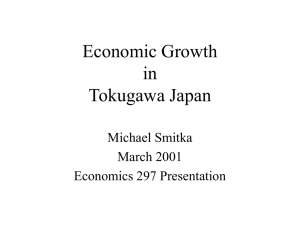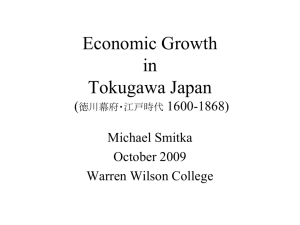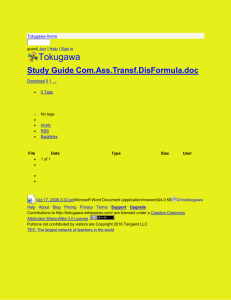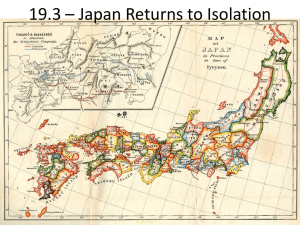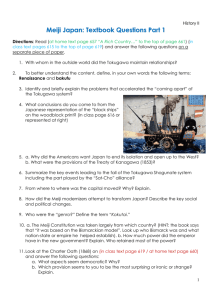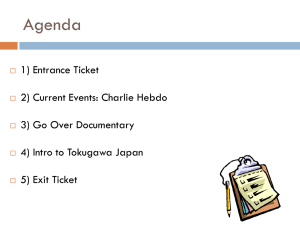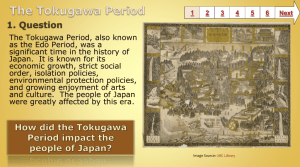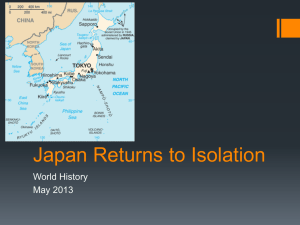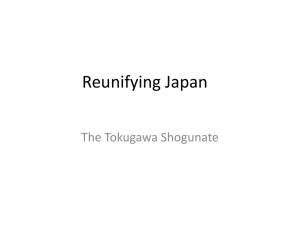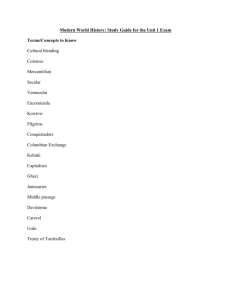Economic Growth in Tokugawa Japan
advertisement
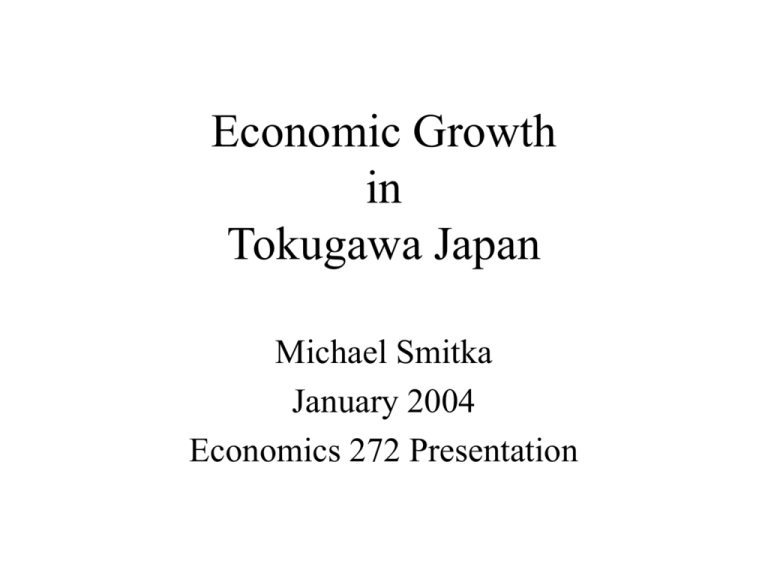
Economic Growth in Tokugawa Japan Michael Smitka January 2004 Economics 272 Presentation Mid-16th Century Han (“countries”) Issues • was Japan poor? -- standard of living • was the economy static? -- growth process versus political process • institutional, other legacies • Curiosity: merely understanding Edoera Japan (1600-1868) Models not covered in class • economic growth : – Solow one-sector model – Lewis-Fei-Ranis two-sector model • Solow model is simple production function Y = f (K, L, N, tech) [“N” is land] – technical change is core of Solow’s work – capital deepening is a key factor (incl human capital) – population growth can eat up gains • Highlights role of demographics in a traditional, low-investment economy Other factors besides “hard” tech • organizational & institutional change are both underrated – “Smithian” growth via specialization and trade: “classical” growth in all senses of the word – government provision of infrastructure, other public goods – development of business networks and accepted practices in markets Demographics • population growth can swamp positive factors. • indeed, for most of human history standards of living changed little • how about Japan? -- and if not, why? Basic Historical Overview • breakdown of old Muromachi order • continual warfare during 1500s, – development of techniques: large, musket-using armies made samurai obsolete and were equal to anything the Spanish had • spread of irrigated rice, other new crops (cotton) • diffusion of civil engineering techniques from China enabling much more irrigation Geopolitical context • 1540: arrival of Francis Xavier & diffusion of muskets • Legitimate fears of invasion – Colonization of Philippines – Weakening & Collapse of Ming China • End of endemic war / unification under Oda Nobunaga & Toyotomi Hideyoshi • Trade in silver for silk: no bulk goods enduring pacification under Tokugawa Ieyasu (1600) • Tokugawa shogunate organized in 1603 – – – – Tokugawa Ieyasu & allies won final battle in 1600 Only controlled 25% of country directly Large “tozama” han (countries) never conquered How to maintain the peace? • Foreign affairs • Sankin kotai - hostages, alternate attendance in Edo • Separate samurai from farmers Unification = ? • multiple “kuni” (country?!) – each headed by a semi-autonomous “daimyo” (lord) – variations in laws, economic structure – National cadastral survey was basis of land tax • roughly 250 political-economic units – Most extremely small – Samurai moved to cities: forestalls peasant revolts – Peasants disarmed Growth stimulus? • Tokugawa control system had: – implications for macroeconomic resource flows in a two-sector context – implications for commercialization and monetization of the economy • Lewis two-sector model: forced flows? – Attendance in Edo (Tokyo) forced development of financial system and logistics Government role • the Edo “bakufu” fostered navigation – port and lighthouse development – maps etc. all by around 1720 • formal financial markets promoted – – – – rice futures market in Osaka by 1720 transferring money in place of in-kind taxes insurance markets (esp. casualty) local (rural) finance by 1800s Market-oriented economy • especially intense development in several regions – cash-crop farms around Osaka (farmers bought food!) – large urban consumer market • commercial elite for whom political advancement was foreclosed (cf. English Dissenters) • education spread. – ukiyoe were for mass-market (wedding presents…) – lots of agricultural handbooks - 200+ titles in print Specialization by the “kuni” (export products) • Silk, cotton, salt, lumber, paper, fish • Some regions largely industrial • Seasonal “proto-industry” often accompanied by regional migration • Both men & women active in wage labor outside the home Technical Change • hard to measure industrial level but – very rapid ability to reproduce industrial revolution technology – clear shifts in agriculture • diminishing returns? – demographic evidence mixed for whole country – but not true (??) for “advanced” regions Standard of Living • transformation of consumption – various rough fibers replaced by cotton; silk worn by more than just elite – new (and better foods). peppers, sweet potatoes / taro, corn, etc. – new and better housing: tatami mats off the ground – vast increases in protein-laden soybean-related consumption (miso, soy sauce) • Education – Literate society, perhaps more so than England! – Vast outpouring of books, circulated through lending libraries – Even nascent “western” studies, esp. in 1800s End of Tokugawa rule • 250 years of peace meant hard to forestall Western imperialists • Delicate political balance made it impossible to increase revenue – taxing goods & commerce would create big winners, politically out – Land tax meant fixed government revenues in a growing economy • US Adm. Perry (1854) and Russians in north forced opening of ports – Beefing up military crucial – Personalities ruled out restructuring Tokugawa domestic accord • Lack of national government, lack of standing army no longer tenable • Outside tozama han put together alliance and toppled the Tokugawa family in a nearly-bloodless coup • Only remaining national symbol - the Emperor - used by victors Meiji - Taisho • New “Meiji Restoration” set up a national govt – Tax system – Military – Bureaucracy & education, modeled mainly after Continental rather than American systems • Samurai lost their legal status - but not a big deal, since most were relatively poor if well-educated • Rapid change, building upon base of Edo advances • Luck, too: silk and rice found foreign markets at the crucial initial juncture Geopolitical concerns late Meiji [1868-1911] - Taisho eras [1912-1925] • Korea viewed as key focal point – 1895 war with China (Taiwan as colony) – 1905 war with Russia – Annexation in 1910 as colony • Boomed during WWI as non-combatant – Textile exports, using imported cotton • Subsequent foreign threats (Russia and US) – Naval buildup destabilizing – Control of Manchuria (forestalling Russia) went awry • Ultimately military coups (1934-36) displaced a cabinet system under elected officials WWII early Showa (1925-1989) • By the start of full war in China in 1937 – Sophisticated financial system – Large manufacturing base – Universal primary education • Even Nobel award winner in physics – Railroads, other domestic infrastructure – Professional managers in large enterprises – Rapidly shrinking agricultural population • Retrogression through early 1950s: 15 years to return to prewar peak Data • Following slides provide select data and pictures of technology for Edo ear • See library for the period from 1868-1945, e.g. – Economic growth in prewar Japan / Takafusa Nakamura ; translated by Robert A. Feldman,Yale University Press 1983 HC462.8 .N25513 1983 – Cambridge History of Japan, various entries, DS835 .C36 1988 – The interwar economy of Japan : colonialism, depression, and recovery, 1910-1940 / edited with introductions by Michael Smitka. Garland Pub., 1998 HC462.7 .I584 1998 – Japanese prewar growth : lessons for development theory? / edited with introductions by Michael Smitka Garland Pub., 1998 HC462.7 .J385 1998 Shipping Routes after 1720 Area of Indica (short-grain) Rice Cultivation – early 1700s – darker hatching indicates greater cultivation of indica rice – Kawaguchi Ironware Zaguri (silk weaving machine) Loom (karabikibata) c. 1770 Spinning Silk Whale Processing Factory Population Growth Rates Region Kinki Tokai Kanto Tohoku Tozan Hokuriku105.3 San'in San'yo Shikoku Kyushu 1798 93.5 100.1 85 86 106.1 118.8 106.8 111.7 105.3 1804 120 109.9 114.9 107.3 1828 129.9 119.8 123.8 111.3 1721 = 100 Kinki, Tokai, Kanto, Tohoku, Tozan all fell. Hokuriku slow growth old data 1834 -1834 132.7 121.8 126.1 112.2 1798 117.6 11.7% 14.0% 12.9% 6.6% 1846 93.5 106.6 86.6 88.7 110.1 11.7% 124.8 120.2 126.8 113.8 ‘98-’46 0.0% 6.5% 1.9% 3.1% 3.8% 4.0% 9.4% 10.4% 6.1% 48 years selected regions, Agriculture Outgrows Population Tokugawa Population & Agriculture 50.00 46.00 42.00 38.00 34.00 30.00 26.00 22.00 18.00 14.00 10.00 1600 1650 Population (millions) 1700 1720 1730 1750 Arable Land (100,000 í¨) 1800 1850 1872 Agricultural Output Tokugawa Population & Agriculture Year 1600 1650 1700 1720 1730 1750 1800 1850 1872 Pop (mil) 12.0 17.2 27.7 31.3 32.1 31.1 30.7 32.3 33.1 Arable Farm Land Output 20.7 23.5 28.4 29.3 29.7 29.9 30.3 31.7 32.3 Area per per Pop Pop 19.7 17.25 23.1 13.66 30.6 10.25 32.0 9.36 32.7 9.25 34.1 9.61 37.7 9.87 41.2 9.81 46.8 9.76 Yield per Area 1.64 1.34 1.10 1.02 1.02 1.10 1.23 1.28 1.41 Yield 0.095 0.098 0.108 0.109 0.110 0.114 0.124 0.130 0.145 Specialization in Agriculture Cotton Production Koga county, Harima han near modern Kobe Year Irrigated fields Dryland Reclaimed Total 1801 1807 1813 1822 1832 1842 1847 0.4% 0.6 3.0 4.3 0.5 2.2 1.5 13.7% 15.1 41.5 38.6 34.5 38.6 35.2 28.5% 25.2 36.9 36.8 34.8 36.9 35.2 8.2% 8.2 17.3 17.4 13.4 16.2 14.5 Note: I find it surprising that any irrigated fields were used for cotton instead of rice! In the 1880s imports led to a sharp drop in domestic output, and production ceased by 1900. Shifts in Family Structure Average for Selected villages Suwa Region, modern Nagano Prefecture Year Avg. Household Size Nishiko Yamaura Avg Couples per Household Nishiko Yamaura 1671-1700 1701-1750 1751-1800 1801-1850 1851-1870 7.87 6.14 4.66 4.22 4.31 1.97 1.41 1.32 1.25 1.20 8.55 9.93 6.94 4.73 4.48 1.83 2.34 2.05 1.37 1.30 Osaka as an Entrepot (1714) Principal non-Rice Imports / Exports Imports Marine products Agricultural items Clothing & textiles Oilseed Mining products Fertilizer Wood products Misc Imports Tea & tobacco Tatami Kyoto crafts Total (Ag value) 20.2% 19.5 15.4 12.9 7.5 6.4 5.9 4.1 2.8 2.0 0.9 286,561 kan Exports Oil & beeswax 36.4% Clothing & textiles 25.2 Misc tools 7.5 Misc exports 7.3 Processed food 6.1 Accessories & decorations 5.8 Lacquerware & pottery 4.6 Seedcake (fertilizer) 3.4 Furniture 0.5 Weapons 0.5 Arts & crafts 0.4% Total 95,800 kan Extent of Cotton Cultivation Japan remained able to shift land out of food crops Growth of a National Market Rice Price Movements Converged in the 17th Century Structure of National Output – 1874 – • shortly after “opening” to the West • before significant structural change from – new technologies – convergence of domestic & international prices
